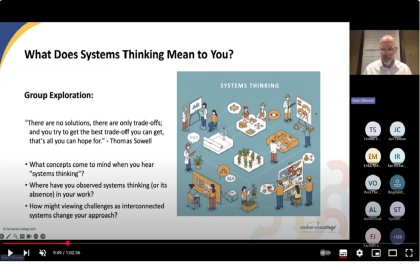What happens when traditional problem-solving doesn’t work—when quick fixes fall short, and decisions in one department ripple into problems in another?
That’s where systems thinking comes in.
In an age of complexity—interwoven social challenges, political uncertainty, and rapid technological change—public sector leaders need more than technical expertise. They need a new mindset. At Civil Service College, our recent webinar “Systems Thinking: Gaining Professional Advantage in a Complex World” with Professor Stan Gilmore explored just that: how systems thinking can help civil servants navigate today’s interconnected realities with greater clarity and impact.
Beyond Silos: Understanding the System
At its core, systems thinking is about seeing the bigger picture. It asks leaders not just to fix what’s broken, but to understand how parts of a system influence one another—how housing policy affects health outcomes, how procurement choices impact social value, or how justice, education, and community engagement must work together to reduce crime.
As one participant shared during the session, “There are no real solutions—only trade-offs.” That humility sits at the heart of systems thinking. It’s not about perfection but balance: weighing priorities, anticipating unintended consequences, and aligning stakeholders to shared goals.
Systems Leadership: Turning Insight into Action
Understanding complexity is one thing—leading through it is another.
Professor Gilmore introduced the distinction between systems thinking (a mindset) and systems leadership (applied behaviour). Systems leaders operate without relying on formal authority. They build trust, connect across boundaries, and influence through relationships. In today’s public sector, where formal hierarchies are often blurred by collaboration, these skills are essential.
Frameworks like BANI—Brittle, Anxious, Nonlinear, and Incomprehensible—offer a new vocabulary to describe the realities many leaders face. Unlike the older VUCA model, BANI emphasises fragility and the emotional toll of uncertainty. Recognising that helps leaders design more adaptive, resilient strategies.
Real-World Impact: From Healthcare to Antisocial Behaviour
Throughout the webinar, we heard powerful examples of systems thinking in action:
- Integrated care pathways that bridge clinical and social services.
- Violence reduction programmes that involve schools, police, and community groups.
- Procurement that values long-term social outcomes, not just cost efficiency.
- Early intervention projects linking housing and children’s services.
These stories show that when departments align their efforts, they not only prevent issues from worsening—they deliver public services that are more joined-up, responsive, and humane.
Why It Matters: Learning to Lead in Complexity
Systems thinking encourages us to slow down and reflect before rushing to act. It challenges the instinct to work in silos or revert to command-and-control. Instead, it invites questions:
- Who else is affected by this decision?
- What patterns or feedback loops are at play?
- Where are the trade-offs—and are they justifiable?
For public servants striving to lead meaningful reform, these questions are invaluable.
What’s Next? Building Capability and Culture
Adopting a systems mindset is a journey. It involves building cross-functional relationships, mapping connections, and fostering cultures of curiosity and collaboration. It also means recognising that change takes time—and that resilience, reflection, and empathy are as critical as technical skills.
We’re grateful to Professor Stan Gilmore and all the public service professionals who contributed to this rich conversation. Their insights help shape a more adaptive, strategic, and compassionate public sector.
This is just the beginning of our exploration into systems leadership. We look forward to continuing this dialogue with colleagues across the UK and beyond.

